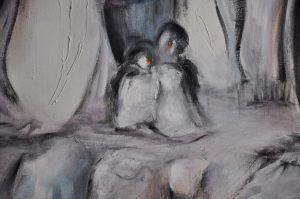 From the time that I began to create abstract paintings, it became somewhat of a challenge to help viewers understand my work. Other painters have had the same experience. When the paintings are representational there are few questions; but, when a painting does not easily relate to a viewer’s frame of reference it often is difficult for some viewers to give the painting serious consideration much less feel the energy and excitement that the painter was trying to communicate.
From the time that I began to create abstract paintings, it became somewhat of a challenge to help viewers understand my work. Other painters have had the same experience. When the paintings are representational there are few questions; but, when a painting does not easily relate to a viewer’s frame of reference it often is difficult for some viewers to give the painting serious consideration much less feel the energy and excitement that the painter was trying to communicate.
To introduce the concept of abstract painting to folks who previously might not have given it much credibility, I have found that the following approach to thinking about abstract paintings seems to make such viewers more comfortable:
A music composition, similar to an abstract painting, is also a statement. Trying to explain a musical idea is just as impossible as it is to explain an abstract painting. Musicians communicate globally with music as a common language; but, they don’t try to explain it. Listeners don’t expect or need such an explanation to enjoy it.
An abstract painting generally will not relate to a viewer’s visual experience depending on how abstract the painting is. The basic elements of painting – line, color, texture, space, shape and composition – can provide a foundation for understanding an abstract painting just as quarter and half notes, sharps and flats and measures can provide a fou ndation for understanding a music composition. Abstract painting, however, like a music composition is a sensory experience and can be enjoyed without an explanation.
ndation for understanding a music composition. Abstract painting, however, like a music composition is a sensory experience and can be enjoyed without an explanation.
A verbal attempt to give meaning to a music idea or an abstract painting idea is essentially an effort to use one language to explain another and is unnecessary. They are what they are, unique languages that do not need validation based on a personal frame of reference.
